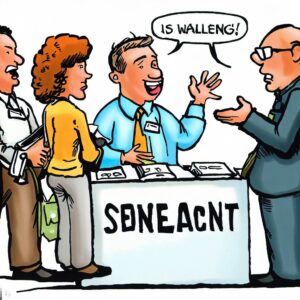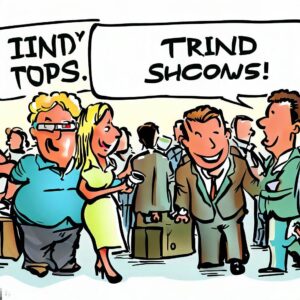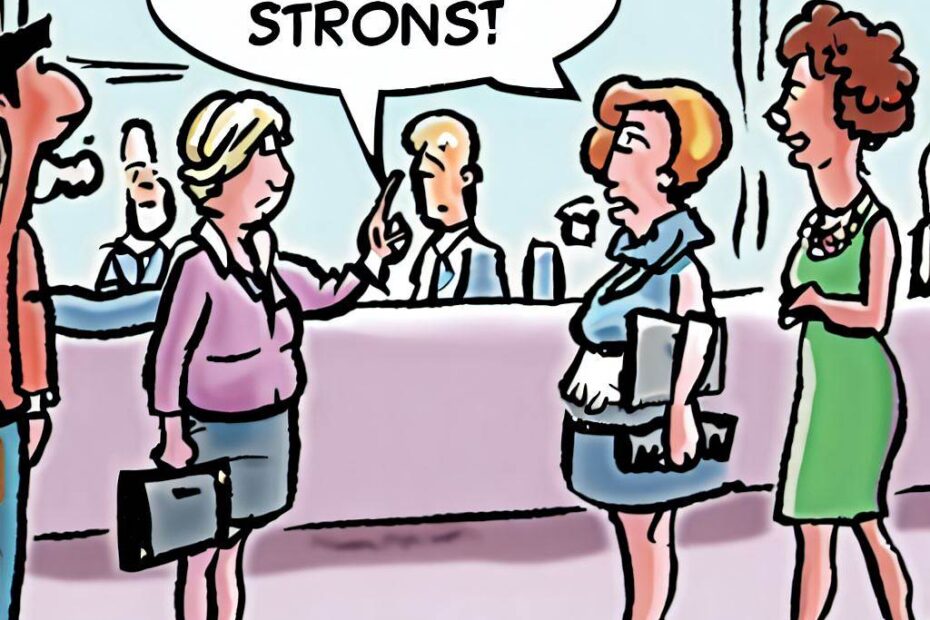In this article, we will share essential trade show tips for attendees that can empower you to navigate these events with confidence and achieve your goals effectively. Participating in a trade show offers a valuable chance to network, gain industry insights, and explore innovative products or services. To maximize your experience, it is crucial to approach the event with preparation and a well-defined plan.
Preparing for the Trade Show
To maximize the benefits of attending a trade show, it is crucial to invest time in thorough research and preparation beforehand. Here are some valuable tips to help you get started and make the most out of your experience:
1 – Research the Event
To optimize your experience at the trade show, it is essential to conduct thorough research on the event. Begin by visiting the official website, where you can access valuable information regarding the exhibitors, schedule, and floor plan. This preliminary investigation will enable you to identify the booths or sessions that align most closely with your interests and objectives.
By exploring the official website, you can gain insights into the participating exhibitors, their products or services, and any special features or promotions they may offer. Understanding the exhibitor landscape will allow you to prioritize your visit and allocate time to the booths that are most relevant to your industry or specific business needs.
Additionally, reviewing the event schedule will help you plan your time effectively. Identify keynote speeches, panel discussions, or workshops that align with your professional goals or address topics of interest. By attending these sessions, you can gain knowledge, network with industry experts, and stay updated on the latest trends and developments in your field.
Furthermore, familiarizing yourself with the floor plan is crucial for navigating the trade show efficiently. Identify the locations of key exhibitors or areas of interest to ensure you don’t miss out on valuable opportunities. By having a clear understanding of the layout, you can optimize your time and avoid aimlessly wandering through the event.
Conducting comprehensive research on the trade show’s official website empowers you to make informed decisions about which booths or sessions to prioritize. This strategic approach will enhance your overall experience, maximize networking opportunities, and ensure you derive the greatest possible value from attending the event.

2 – Set Clear Goals
Setting clear goals is essential when attending a trade show. It is crucial to define your objectives and determine what you hope to achieve from the event. Are you primarily interested in networking with industry professionals, gaining knowledge about new products and innovations, or exploring potential partnerships? By clarifying your goals, you can effectively plan your time and maximize the benefits of attending the trade show.
Having clear goals provides you with a roadmap for success. It allows you to focus your efforts on activities that align with your objectives, ensuring that you make the most of your time and resources. Without clear goals, you may find yourself wandering aimlessly, missing out on valuable opportunities and connections.
When defining your objectives, consider the specific outcomes you wish to achieve. For networking purposes, you might aim to connect with influential individuals in your industry or establish partnerships with complementary businesses. If your goal is to learn about new products, identify the specific types of products or technologies you are interested in exploring. And if you are seeking potential partnerships, determine the criteria you have in mind for collaboration.
Once you have established your goals, it is important to communicate them to your team or colleagues who will be attending the trade show with you. This ensures that everyone is on the same page and can work together towards achieving the desired outcomes.
Setting clear goals before attending a trade show is vital for success. It helps you prioritize your time, focus your efforts, and make the most of the event by aligning your activities with your objectives. By defining your goals and communicating them effectively, you increase your chances of achieving positive outcomes and maximizing the value gained from attending the trade show.

3 – Plan Your Schedule
Planning your schedule is a crucial step in making the most of any event, including trade shows. By carefully reviewing the event schedule and creating a personalized itinerary, you can ensure that you don’t miss out on valuable sessions and opportunities.
Start by thoroughly examining the event schedule and identifying the keynote speakers, workshops, or panel discussions that align with your interests and goals. Look for sessions that cover topics relevant to your industry, address current trends, or offer insights that can benefit your business. Consider the expertise of the speakers and the potential value they can bring to your understanding and professional development.
Once you have identified the sessions of interest, make note of their timings and locations. This will help you plan your day effectively, ensuring that you allocate sufficient time for each session and account for any logistical considerations, such as travel time between different venues or stages.
While planning your schedule, it’s also important to keep some flexibility. Leave room for impromptu networking opportunities, spontaneous conversations, or unexpected discoveries that may arise during the event. Trade shows often present unexpected opportunities to connect with industry leaders, engage in meaningful conversations, or stumble upon innovative products or services. By allowing some flexibility in your schedule, you can take advantage of these serendipitous moments.
Additionally, consider prioritizing sessions that offer interactive elements, such as workshops or Q&A sessions, as they provide valuable opportunities for engagement and learning. These sessions often allow for direct interaction with industry experts and peers, enabling you to ask questions, share insights, and build meaningful connections.
Planning your schedule for a trade show involves carefully reviewing the event schedule, identifying sessions of interest, and creating a personalized itinerary. By allocating time for key sessions, considering flexibility, and prioritizing interactive opportunities, you can ensure that you make the most of the event and derive maximum value from your attendance.

Maximizing Your Time at the Trade Show
To ensure a successful trade show experience, it is crucial to maintain organization and maximize your time effectively. Here are some valuable tips to help you make the most out of your participation:
1 – Dress Appropriately
When attending a trade show, it is essential to dress appropriately to make a positive impression and ensure your comfort throughout the event. Here are some tips to help you choose the right attire for the occasion.
First and foremost, prioritize comfort when selecting your footwear. Trade shows typically involve a significant amount of walking, so opt for comfortable shoes that provide adequate support. Consider wearing well-fitting sneakers, loafers, or low-heeled shoes that will keep your feet comfortable and minimize the risk of fatigue or discomfort.
While comfort is important, it’s equally crucial to dress in professional attire that aligns with the expectations of your industry. Your clothing should reflect your professionalism and create a favorable impression among peers, potential clients, and industry experts. Research the dress code for the trade show or industry and select appropriate clothing accordingly. For formal industries, such as finance or law, a business suit or formal attire might be appropriate. In more casual industries, like technology or creative fields, business casual attire may be acceptable. Dressing appropriately shows that you take the event seriously and respect the professional environment.
Consider the nature of the trade show and the target audience when deciding on your outfit. If you are representing a company or brand, wearing branded attire or accessories can help create a cohesive and recognizable image. However, avoid excessive branding or promotional materials that can appear overly promotional or distracting.
Lastly, pay attention to personal grooming and hygiene. Ensure that your clothes are clean, well-pressed, and free from wrinkles or stains. Maintain good personal hygiene and grooming standards to present yourself in a professional and approachable manner.
When attending a trade show, prioritize comfort by choosing appropriate footwear for the amount of walking involved. Simultaneously, dress professionally in attire that reflects your industry and aligns with the event’s dress code. By striking the right balance between comfort and professionalism, you can make a positive impression, feel confident, and navigate the trade show with ease.

2 – Bring Business Cards
When attending a professional event, such as a trade show, it’s crucial to come prepared with an ample supply of business cards. These small but mighty tools serve as a tangible representation of your professional identity and enable you to exchange contact information with exhibitors, speakers, and fellow attendees. Here’s why bringing business cards is essential and how they can benefit you during and after the event.
First and foremost, business cards facilitate seamless networking. By exchanging business cards with others, you create a tangible connection that goes beyond a simple conversation. It allows you to share your contact information quickly and efficiently, ensuring that potential leads, collaborators, or industry peers can easily reach out to you after the event. Moreover, when you receive someone else’s business card, it serves as a reminder of the conversation and helps you recall the context and potential opportunities associated with that individual.
Business cards also convey professionalism and preparedness. By presenting a well-designed and informative business card, you showcase your attention to detail and commitment to your professional image. It demonstrates that you are serious about establishing connections and that you value the potential for future collaboration or business opportunities.
When designing your business cards, consider including essential information such as your name, job title, company name, contact number, email address, and website. You may also want to include your social media handles or a brief tagline that captures your expertise or unique value proposition. Ensure that the design is clean, legible, and visually appealing to make a lasting impression.
After the event, business cards serve as a valuable resource for follow-up communication. When you meet someone who could be a potential client, partner, or mentor, having their business card allows you to reach out and continue the conversation. It’s a professional and courteous way to demonstrate your interest and maintain the connection beyond the event’s timeframe.
Bringing business cards to a trade show or any professional event is essential for effective networking and follow-up. They serve as a tangible representation of your professional identity, facilitate seamless information exchange, and convey professionalism and preparedness. By utilizing business cards, you can establish connections, nurture relationships, and maximize the opportunities that arise from attending such events.

3 – Engage with Exhibitors
When attending a trade show or similar event, it’s crucial to actively engage with exhibitors by visiting their booths and initiating meaningful conversations. By taking the time to ask questions, express genuine interest in their products or services, and collect relevant materials, you can unlock a wealth of valuable insights and potential business opportunities. Here’s why engaging with exhibitors is essential and how it can benefit you during and after the event.
First and foremost, engaging with exhibitors allows you to gather firsthand information about their offerings. By asking targeted questions, you can delve deeper into their products or services, understanding their unique features, benefits, and potential applications. This interaction provides you with a comprehensive understanding of what exhibitors have to offer, enabling you to make informed decisions and identify potential collaborations or partnerships that align with your needs or business objectives.
Furthermore, engaging with exhibitors opens the door to valuable networking opportunities. These interactions allow you to establish connections with industry professionals, decision-makers, and subject matter experts. By expressing genuine interest in their offerings, you demonstrate your commitment to staying informed and your willingness to explore potential synergies. Exhibitors may also appreciate your enthusiasm and be more inclined to remember and follow up with you after the event.
Collecting brochures, materials, or samples from exhibitors is another valuable aspect of engagement. These resources provide you with tangible information that you can review at your convenience. They serve as a reference point for further research, comparison, or evaluation of different products or services. Additionally, having these materials on hand allows you to share relevant information with colleagues, stakeholders, or potential clients who may benefit from the exhibitor’s offerings.
After the event, the connections and insights gained from engaging with exhibitors can lead to potential business opportunities. By nurturing the relationships established during the event, you can explore collaborations, partnerships, or even sales opportunities that may arise. Following up with exhibitors and staying in touch keeps you on their radar and allows you to leverage the initial interaction into a more meaningful and mutually beneficial relationship.
Actively engaging with exhibitors at a trade show or similar event offers numerous benefits. It provides you with firsthand information, valuable networking opportunities, and tangible resources that can guide your decision-making process. By asking questions, expressing genuine interest, and collecting relevant materials, you can unlock valuable insights and potential business opportunities that can contribute to your professional growth and success.

Networking and Learning Opportunities
Trade shows present valuable opportunities for networking and learning. To fully capitalize on these advantages, consider the following strategies to make the most of your trade show experience:
1 – Attend Workshops and Presentations
When attending a professional event, it is highly beneficial to actively participate in workshops, presentations, and panel discussions that are relevant to your industry. These sessions offer a unique opportunity to gain valuable insights from industry experts and thought leaders, enabling you to expand your knowledge, stay updated on current trends, and enhance your professional growth. Here’s why attending workshops and presentations is crucial and how it can benefit you during and after the event.
First and foremost, workshops and presentations provide a platform for industry experts and thought leaders to share their expertise and insights. By attending these sessions, you have the opportunity to learn from the best in the field, gaining knowledge and perspectives that can significantly impact your professional development. These experts often share valuable strategies, best practices, and innovative ideas that can inspire you and help you stay ahead of the curve in your industry.
Furthermore, workshops and presentations foster networking and collaboration opportunities. These sessions attract like-minded professionals who share a common interest in the topic being discussed. By actively participating in these sessions, you can engage in meaningful conversations, exchange ideas, and connect with individuals who may become valuable contacts, mentors, or even potential collaborators. Networking with attendees and speakers can open doors to new opportunities, partnerships, or career advancements.
Attending workshops and presentations also demonstrates your commitment to continuous learning and professional growth. It showcases your eagerness to stay updated on industry trends, challenges, and advancements. This dedication to self-improvement can enhance your professional reputation and position you as a knowledgeable and forward-thinking individual within your industry.
After the event, the knowledge and insights gained from attending workshops and presentations can be applied in your work. You can implement new strategies, adopt best practices, or explore innovative ideas that were shared during these sessions. This can lead to improved performance, increased efficiency, and enhanced problem-solving skills, ultimately contributing to your professional success.
Actively participating in workshops, presentations, and panel discussions at professional events offers numerous benefits. It allows you to learn from industry experts, expand your knowledge, and stay updated on current trends. Additionally, it provides networking opportunities and showcases your commitment to continuous learning. By attending these sessions, you can gain valuable insights, forge meaningful connections, and apply newfound knowledge to your work, ultimately driving your professional growth and success.

2 – Network Strategically
When it comes to networking, adopting a strategic mindset is crucial for maximizing the benefits of your efforts. Instead of relying on chance encounters, take a proactive approach by identifying key individuals or companies that you would like to connect with and actively seek out opportunities to engage with them. By introducing yourself and initiating meaningful conversations, you can establish valuable connections that can lead to various opportunities. Here’s why strategic networking is essential and how you can make the most of it.
First and foremost, strategic networking allows you to focus your efforts on individuals or companies that align with your professional goals or interests. By identifying key players in your industry or specific organizations that you admire, you can prioritize your networking efforts and make targeted connections. This approach ensures that your networking activities are purposeful and increase the likelihood of forming meaningful relationships that can bring value to both parties involved.
Being proactive in introducing yourself and initiating conversations demonstrates your genuine interest in building connections. It shows that you are willing to take the initiative and invest time and effort in fostering professional relationships. By approaching networking with a proactive mindset, you can break the ice, establish rapport, and create a positive impression that can lead to further engagement and collaboration.
When engaging in meaningful conversations, it’s important to be prepared and demonstrate your knowledge and expertise. Research the individuals or companies you plan to connect with, understand their work, and find common ground that can serve as a starting point for conversation. By showcasing your understanding of their industry or specific challenges they face, you can establish credibility and create a foundation for building a mutually beneficial relationship.
Strategic networking also involves nurturing and maintaining the connections you establish. Following up after initial interactions, staying in touch, and providing value whenever possible are key components of effective networking. By keeping the lines of communication open and demonstrating your willingness to contribute, you can strengthen your relationships and increase the likelihood of future collaborations or opportunities.
Approaching networking with a strategic mindset is essential for maximizing its benefits. By identifying key individuals or companies, being proactive in introducing yourself, and initiating meaningful conversations, you can establish valuable connections that align with your professional goals. Additionally, staying prepared, showcasing your expertise, and nurturing the relationships you form contribute to the long-term success of your networking efforts. By networking strategically, you can create a network of valuable contacts, mentors, and collaborators that can support your professional growth and open doors to new opportunities.

3 – Follow Up
Following up with the contacts you made after a trade show is a crucial step that should not be overlooked. It is important to maintain the momentum and build upon the initial connection you established. Sending personalized emails or LinkedIn messages is an effective way to express your gratitude for meeting them and explore potential collaborations or partnerships. Here’s why following up is essential and how you can make the most of it.
First and foremost, following up demonstrates your professionalism and genuine interest in maintaining the relationship. It shows that you value the interaction you had at the trade show and that you are committed to nurturing the connection further. By taking the initiative to reach out, you leave a positive impression and increase the likelihood of continued engagement.
When sending follow-up messages, it is crucial to personalize them. Mention specific points from your conversation or any shared interests or goals that were discussed. This personalized approach shows that you were attentive during your interaction and that you value the individual’s time and input. It also helps to establish a stronger connection by creating a sense of familiarity and relevance.
In your follow-up message, express your appreciation for meeting them and highlight any key takeaways or insights you gained from the conversation. This not only reinforces the positive impression you made but also shows that you were actively engaged and found value in the interaction. Additionally, take the opportunity to express your interest in exploring potential collaborations or partnerships. This opens the door for further discussions and allows you to leverage the initial connection for future opportunities.
Utilizing platforms like email or LinkedIn for your follow-up messages provides a professional and convenient means of communication. Be sure to proofread your messages for clarity, tone, and grammar to ensure they are well-crafted and error-free. Promptly responding to any replies or inquiries that arise from your follow-up messages is equally important. It demonstrates your responsiveness and commitment to maintaining the relationship.
Following up with the contacts you made after a trade show is a critical step in building and nurturing professional relationships. By sending personalized messages, expressing gratitude, and exploring potential collaborations or partnerships, you can solidify the initial connection and create opportunities for future engagement. Remember to be attentive, genuine, and professional in your follow-up efforts, and promptly respond to any communication that arises. By effectively following up, you can maximize the value of the connections you made at the trade show and pave the way for fruitful collaborations and long-term partnerships.

Conclusion
Attending a trade show can be a rewarding experience if approached with proper planning and preparation. By researching the event, setting clear goals, and maximizing your time through effective networking and engagement, you can make the most of these valuable opportunities.
Remember, trade shows are not only about collecting freebies but also about building relationships and staying updated with industry trends. With these trade show tips for attendees, you’re now equipped to navigate these events successfully and derive maximum value from your participation.
